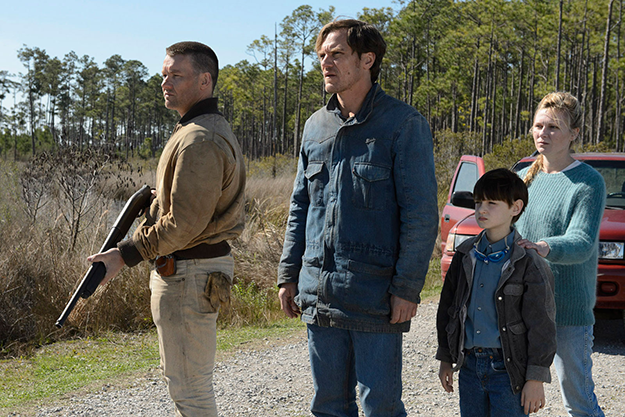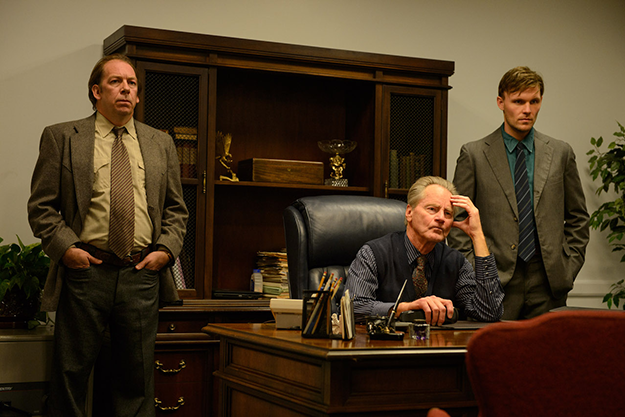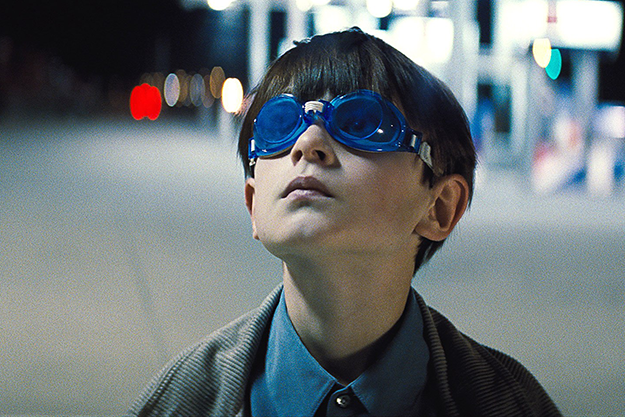Midnight Special traverses backroads (and genres) as a cultish religious congregation figures into the scenario and Alton demonstrates some extraordinary abilities. Last week, FILM COMMENT chatted with Nichols (whose next film, Loving, concerns the interracial couple sentenced to prison in 1958 for marrying) about the ins and outs of the studio process, the meaning of final cut, and the negotiations with narrative that he makes with his viewers.
How do you describe the movie without giving anything away? I start off with the thing the poster starts off with, which is a genre invitation to the audience. Which is to say a sci-fi chase movie. So, get your popcorn, come see a sci-fi chase movie. But when I really talk about the movie, I talk about it as a story about a father and a son on the run. And if I go a little bit deeper than that, I talk about how it really is a meditation on the relationship between parents and their children. I drew a really big line in the sand when we started talking about marketing with Warner Bros. I said: “These are the things that you are going to need to show just to get anybody to sit up and pay attention. But here are the things you can’t show.” You’ve spoken about being influenced by Starman and Close Encounters of the Third Kind. There’s a bit of The Sugarland Express in your movie as well. The title itself is a clue in a way, isn’t it? Yeah, of course. And at some point I think you have to give people a sense of what they’re getting into. And I think that genre is a shorthand that you use with audiences in order to invite them into the theater. How different was it working inside the studio system? On set I had the same crew that I’ve always worked with—of course with a few more people added. But, you know, I felt relatively safe. It felt very similar to the other films I made in terms of process. It’s not like the script went through a development process inside the studio. I went to them with the whole package essentially—with Michael Shannon attached—and said, this is what I want to do. They liked it, and to their credit I think they really stood by it through the whole process. These are all very intelligent people. They knew what they were buying, especially at this budget level. Could there have been a $75 million version of this instead of a $20 million version? I thought I was very smart taking them a $20 million film. I thought it would be an easier sell. I really wanted to make something like the first Terminator. Not in terms of aesthetics or sci-fi or anything like that. That first Terminator film was just very tightly wound. It felt like this kernel that could explode, did explode into a mega-franchise. I didn’t think my film would necessarily end up being like that, but I liked that idea and I thought maybe the studio could see it that way. With franchises now, people are diving into backstories and prequels and everything else. I thought, well, here’s something that could be an inexpensive way to generate more. The reaction I got was: “We don’t do that. We make $100 million films so that we can make $400 million. We don’t make $20 million films so that we can maybe hope to eke out $50 million. It’s the same amount of work for us.” But, in fact, at some point they asked: “Do you have the second one? Because we’ll just take the second one.”
You still managed to earn final cut. The final cut thing, in a weird way, I brought that out publicly. Not to beat my chest or anything like that, but to assure fans of my films in the past: “Don’t be afraid.” I wanted people to know that I stand by this movie as my own. If you don’t like it, blame me. Don’t blame anybody else. But in reality, at a studio, final cut is kind of like the nuclear option. It’s not something that you really want to use. Those people who are paying for your movie and paying for its release, you want them to like it and feel that they’re a part of it. It’s not like they’re just some bank that you go to for a loan to make your movie. You’re deliberately tough on viewers in the film. You don’t explain a lot and you provide very little backstory. Not everyone will understand what’s going on. There were very specific things that I set out to do when I wrote this script. It was written in a very lean manner in terms of exposition and everything else. They were the foundational principles of the script. And I had to decide at times, okay, people want to know more about this or that issue. Why? Is there a way to tell them more, to make the film more satisfying, without undercutting my idea of not putting narrative exposition in the film? It was honestly a narrative experiment. I say that, but I don’t know if people are really listening to me. There are certainly disadvantages, you know? It’s like making a deal with people. You, the viewer, may not get everything, and I, as a filmmaker, have to accept the consequences of that. But hopefully there are other experiences that you might get as a result of this storytelling style. You might have a deeper experience with the film as a result of it. I feel like I’m a very pragmatic writer. I don’t purposely try to obfuscate. I don’t purposely try to leave things confusing. In fact, that’s the exact opposite of what I want. The critique that I take squarely on the jaw is that sometimes it does feel that my characters are ambiguous on purpose. I think that’s when the style fails. When it feels like that’s not how a person would talk in that scene, because they would really be like: “What the hell’s going on?” When you’re writing, you build a tremendous amount of backstory. After the movie’s ended, you step back as a writer and you see this giant timeline. I tried to make a rule that I’m going to take a clean chunk out of this timeline. I won’t try to influence characters’ behavior just to get story points in. So at the beginning of Midnight Special, for example, when the boy Alton was born, his parents would have had a lot of questions, right? They would have asked things, they would have investigated things, They would have approached how to take care of him in a certain way. But eight years in, now they’ve lived with Alton, they understand him at this point in his life. So they don’t ask the same kind of things that normal people would ask when they first encounter him. Except it’s very tempting as a writer to try and then fold their backstory back into this excerpt that I’ve taken out. And the way that you would fold it back in is to modify the character behavior, so that they talk differently than they would, so they could “fill you in.”
But you still tested the film with focus groups and decided to reshoot some material. Usually when I’m done with my director’s cut, I’m pretty much done. But in this case they tested the film a couple of times. Then you’re inundated with, not just notes from the studio, but hundreds of cards filled out by audience members. It’s kind of like reading tea leaves. Just because people say they want something doesn’t mean they need it. You have to understand why they want that thing. And if it’s a good thing that they want it, is it something that you need to correct, is it a barrier to them receiving the story? And really I think the most difficult part of it is constantly going back and checking yourself against the foundational principles that you built the script out of. There was one scene in particular with Kirsten Dunst’s character in the film. That was the only scene that was created from whole cloth at the end of the process. You’ll have to see the film obviously to understand, but people just—the way her character disappeared originally in the script, which I had no problem with—it was just a barrier to people being able to experience the final moments of the film. They were like, “Where’d she go?” “What happened to her?” And I felt like I was able to come up with a small scene that’s just gonna help that lay down. Again, it didn’t undercut any of these foundational principles, it just helped it lay down. There was another scene with Adam Driver and the boy where I added some dialogue. It wasn’t a brand new scene, it was just a few extra lines. It was really funny, I was working with one of these executives at Warner Bros., and I called him up and said, “Hey, okay, I’ve got it. I’m gonna put some more information in that one scene.” He’s like, “Thank goodness, that’s great!” And I turned in the pages, and he’s like, “Jeff, this is about five lines.” “Yeah, yeah, aren’t they great?” “We were expecting like a monologue, like some paragraphs.” “Oh, no, no, no, this is what I feel comfortable with.” To their credit, they still allowed me to do it. Because they had to pay for it, that additional cost. So there was this—I like to think it was—a constructive push-and-pull. You know you don’t want to just totally bury your head in the sand and not listen—you just have to listen with your original intention in mind. What I admire about your films is that they seem to be happening right in front of the viewer, not in some abstract movie space. I’ve tried to be really pragmatic and honest about behaviors within a scene. If the actor’s able to follow the natural character behavior within a scene, the audience should be too, because no character’s acting outside of himself. No character’s going to do anything that betrays who they are, so you really do feel like you’re tracking one moment to the next. The dots connect. They’re not connecting because of some omniscient hand reaching down moving chess pieces around the board. Does that make sense? It doesn’t matter to me. After that gas station scene, you could have done anything you wanted. I kind of almost did. Daniel Eagan is a critic and film historian living in New York City. He is currently working on the third volume of America’s Film Legacy, a survey of the National Film Registry.


